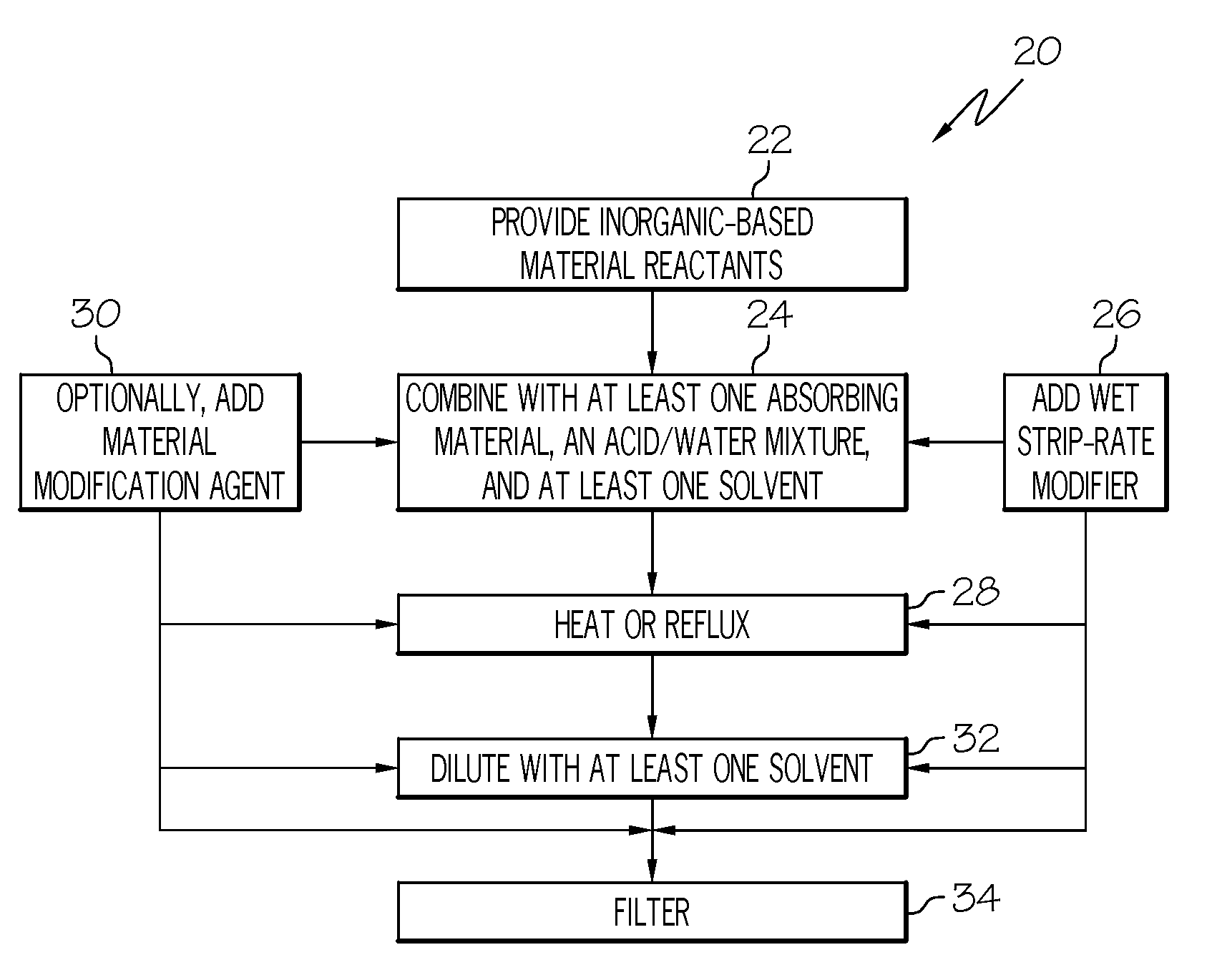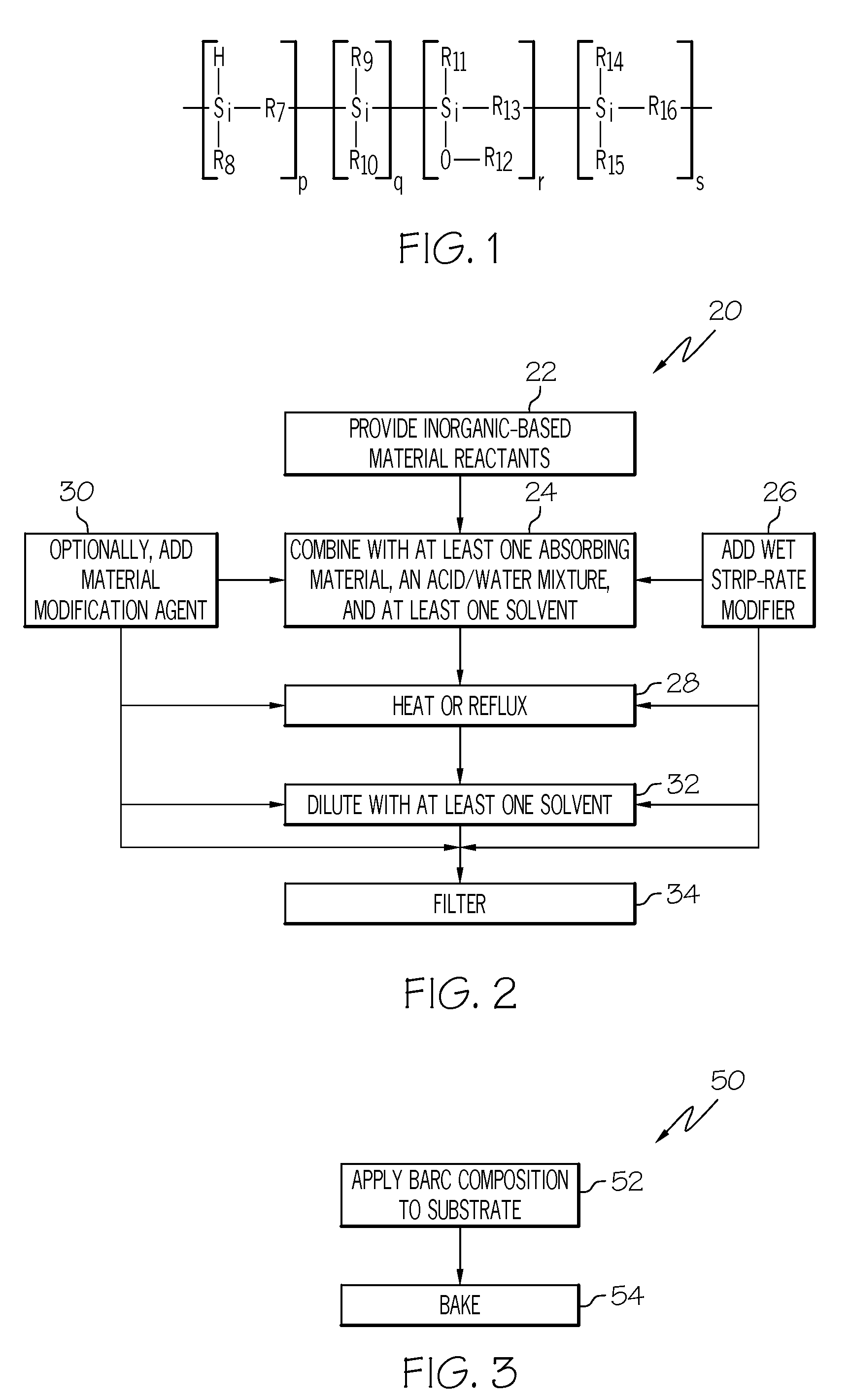Bottom antireflective coatings exhibiting enhanced wet strip rates, bottom antireflective coating compositions for forming bottom antireflective coatings, and methods for fabricating the same
a technology of anti-reflective coatings and compositions, applied in the field of anti-reflective coating compositions and methods for fabricating the same, can solve the problems of increasing the wet strip rate of a barc, introducing new challenges for manufacturing devices with smaller feature sizes, and proving unsatisfactory
- Summary
- Abstract
- Description
- Claims
- Application Information
AI Technical Summary
Benefits of technology
Problems solved by technology
Method used
Image
Examples
example 1
[0089]Into a 1 L flask connected to a water condenser, 297 g of IPA was dispensed and stirred. About 149 g of acetone was then added and the mixture was stirred for 5 min. About 140 g TEOS, 19 g MTEOS and 52 g PTEOS were added under vigorous stirring. 5.6 g of a 0.1 M aqueous nitric acid solution and 67 g deionized water were then added to the mixture. The mixture was refluxed for 4 hours. After 4 hours, the mixture was cooled to 65° C. and 43.77 g of butanol was added. The mixture then was diluted with PGMEA using a 94 g PGMEA / 100 g mixture ratio. APTEOS triflate salt was prepared by combining 4.89 g 20% triflic acid and 1.425 g APTEOS to form a salt solution comprising 22.6% APTEOS. 47 g of ethanol and 8500 ppm APTEOS-triflate salt were added to the diluted formulation and the formulation was filtered using a standard Meissneri® filter of 0.04 micron pore size. The filtered formulation was applied via spin coating at 1500 revolutions per minute (rpm) for 30 sec. onto a silicon waf...
example 2
[0090]Into a 1 L flask connected to a water condenser, 297 g of IPA was dispensed and stirred. About 149 g of acetone was then added and the mixture was stirred for 5 min. About 140 g TEOS, 19 g MTEOS and 52 g PTEOS were added under vigorous stirring. 5.6 g of a 0.1 M aqueous nitric acid solution and 67 g deionized water were then added to the mixture. The mixture was refluxed for 4 hours. After 4 hours, the mixture was cooled to 65° C. and 43.77 g of butanol was added. The mixture then was diluted with PGMEA using a 94 g PGMEA / 100 g mixture ratio. Next, 33 g of ethanol and 14 g n-propanol were added to the diluted formulation. APTEOS triflate salt was prepared by combining 4.89 g 20% triflic acid and 1.425 g APTEOS to form a salt solution comprising 22.6% APTEOS. About 8500 ppm APTEOS-triflate salt was added and the formulation was filtered using a standard Meissneri® filter of 0.04 micron pore size. The filtered formulation was applied via spin coating at 1500 rpm for 30 sec. onto...
example 3
[0091]Into a 1 L flask connected to a water condenser, 297 g of IPA was dispensed and stirred. About 149 g of acetone was then added and the mixture was stirred for 5 min. About 140 g TEOS, 19 g MTEOS and 52 g PTEOS were added under vigorous stirring. 5.6 g of a 0.1 M aqueous nitric acid solution and 67 g deionized water were then added to the mixture. The mixture was refluxed for 4 hours. After 4 hours, the mixture was cooled to 65° C. and 43.77 g of butanol was added. The mixture then was diluted with PGMEA using a 94 g PGMEA / 100 g mixture ratio. Next, 33 g of ethanol, 14 g of n-propanol and 2.8 g of dipropylene glycol (DPG) (in a 2.8 g DPG / 100 g mixture ratio) were added. APTEOS triflate salt was prepared by combining 4.89 g 20% triflic acid and 1.425 g APTEOS to form a salt solution comprising 22.6% APTEOS. About 8500 ppm APTEOS-triflate salt was added to the diluted formulation and the formulation was filtered using a standard Meissneri® filter of 0.04 micron pore size. The fil...
PUM
| Property | Measurement | Unit |
|---|---|---|
| temperatures | aaaaa | aaaaa |
| wavelengths | aaaaa | aaaaa |
| wavelengths | aaaaa | aaaaa |
Abstract
Description
Claims
Application Information
 Login to View More
Login to View More - R&D
- Intellectual Property
- Life Sciences
- Materials
- Tech Scout
- Unparalleled Data Quality
- Higher Quality Content
- 60% Fewer Hallucinations
Browse by: Latest US Patents, China's latest patents, Technical Efficacy Thesaurus, Application Domain, Technology Topic, Popular Technical Reports.
© 2025 PatSnap. All rights reserved.Legal|Privacy policy|Modern Slavery Act Transparency Statement|Sitemap|About US| Contact US: help@patsnap.com



